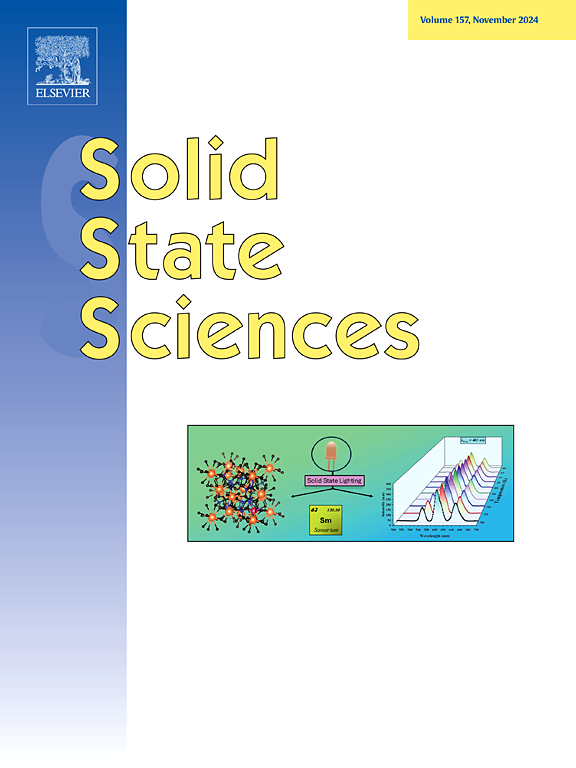超长寿命锌离子杂化超级电容器用煤焦油衍生富氧多孔碳的环保合成
IF 3.3
3区 化学
Q2 CHEMISTRY, INORGANIC & NUCLEAR
引用次数: 0
摘要
锌离子混合超级电容器将电池的高能量密度与超级电容器优越的功率密度和循环稳定性相结合,成为一种很有前途的储能技术。然而,高性能ZHSs电极材料的开发仍然是一个重大挑战。在此,我们报告了一种以煤焦油为原料,以葡萄糖酸钙为多功能模板,以K2CO3为温和活化剂,环境友好地合成了掺杂氧的分层多孔碳。优化后的碳阴极(MCK)具有高达1067.6 m2 g−1的高比表面积和6.05 at%的适当氧掺杂,为Zn2+的储存提供了丰富的活性位点,并促进了高效的离子传输途径。因此,MCK阴极在0.05 a g−1时可提供181.8 mAh g−1的高比容量,优于之前报道的大多数碳基阴极。此外,它还实现了令人印象深刻的能量和功率密度,分别为145.1 Wh kg - 1和13.9 kW kg - 1,以及出色的循环稳定性,100,000次循环后容量保持率为92.98%。这项工作不仅为碳材料设计提供了宝贵的见解,而且为先进的储能应用展示了一种可扩展的绿色合成策略。本文章由计算机程序翻译,如有差异,请以英文原文为准。

Eco-friendly synthesis of coal tar-derived oxygen-rich porous carbons for ultra-long-life zinc-ion hybrid supercapacitors
Zinc-ion hybrid supercapacitors (ZHSs) have emerged as a promising energy storage technology, combining the high energy density of batteries with the superior power density and cycling stability of supercapacitors. Nevertheless, the development of high-performance electrode materials for ZHSs remains a significant challenge. Herein, we report an environmentally friendly synthesis of oxygen-doped hierarchical porous carbons derived from coal tar, using calcium gluconate as a multifunctional template and K2CO3 as a mild activating agent. The optimized carbon cathode (MCK) possesses a high specific surface area up to 1067.6 m2 g−1 and an appropriate oxygen doping content of 6.05 at%, which collectively provide abundant active sites for Zn2+ storage and facilitate efficient ion transport pathways. As a result, the MCK cathode delivers a high specific capacity of 181.8 mAh g−1 at 0.05 A g−1, outperforming most previously reported carbon-based cathodes. Furthermore, it achieves impressive energy and power densities of 145.1 Wh kg−1 and 13.9 kW kg−1, respectively, along with exceptional cycling stability with 92.98 % capacity retention after 100,000 cycles. This work not only offers valuable insights into carbon material design but also demonstrates a scalable and green synthesis strategy for advanced energy storage applications.
求助全文
通过发布文献求助,成功后即可免费获取论文全文。
去求助
来源期刊

Solid State Sciences
化学-无机化学与核化学
CiteScore
6.60
自引率
2.90%
发文量
214
审稿时长
27 days
期刊介绍:
Solid State Sciences is the journal for researchers from the broad solid state chemistry and physics community. It publishes key articles on all aspects of solid state synthesis, structure-property relationships, theory and functionalities, in relation with experiments.
Key topics for stand-alone papers and special issues:
-Novel ways of synthesis, inorganic functional materials, including porous and glassy materials, hybrid organic-inorganic compounds and nanomaterials
-Physical properties, emphasizing but not limited to the electrical, magnetical and optical features
-Materials related to information technology and energy and environmental sciences.
The journal publishes feature articles from experts in the field upon invitation.
Solid State Sciences - your gateway to energy-related materials.
 求助内容:
求助内容: 应助结果提醒方式:
应助结果提醒方式:


